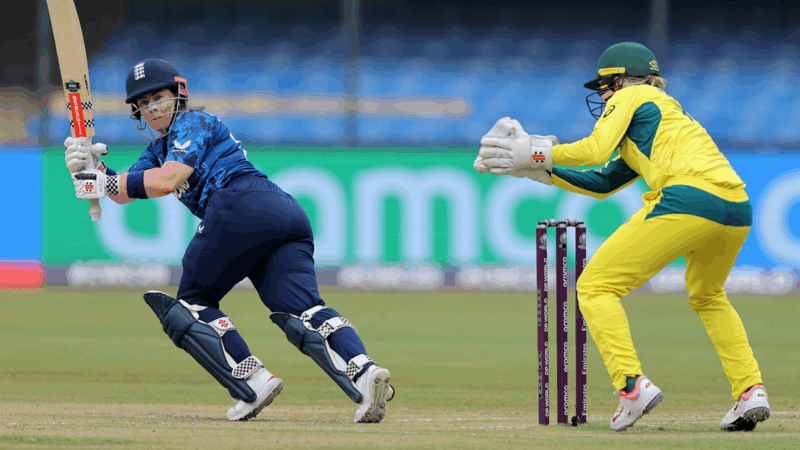Ashleigh Gardner played out three dot-balls after completing her century. One of those was a full toss. But there were cheers from the 8,531-strong crowd at the Holkar Stadium, and laughs and high-fives in the Australia dug-out. Australia were four runs away from handing England their first defeat at the Women’s World Cup 2025. Annabel Sutherland was five away from what would have been a well-deserved century.
Sutherland couldn’t get to her hundred in the next over despite a dropped catch. Gardner then finished off the chase by lofting Sophie Ecclestone over mid-off to maintain Australia’s clean slate in this competition.
Sutherland and Gardner came together when Australia were 68 for 4 in their 245-run chase. They conjured an unbroken 180 for the fifth wicket and, in the process, gave plenty of lessons to England’s batters. Here’s an example.
Sutherland had just laced Lauren Bell, England’s fastest bowler on the park, through extra cover for a four using her long stride. So wicketkeeper Amy Jones came up to the stumps. It did not bog Sutherland down as she was swiftly off strike and Gardner, with the keeper still up, picked up a second four of the over with a slash through backward point.
A score of 68 for 4 is dire enough to opt for a cautious approach. More so with England pressing their spinners into service. But playing out a dot was the last option in Australia’s operating manual. In their entire innings, England faced 169 dot-balls – that is about 28 overs’ worth. Australia played out only 107 dots (fewer than 18 overs) and finished their chase with 57 balls to spare. The Sutherland-Gardner partnership lasted 148 balls: only 51 of those were without a run.
The black-soil pitch in Indore had started to slow down a little and the ball held up just a touch, as evidenced by Ellyse Perry’s wicket. She was early into her flick and popped a catch back to left-arm spinner Linsey Smith. This was in contrast with how Australia’s left-arm spinner Sophie Molineux had dismissed Heather Knight lbw earlier in the afternoon, getting one to skid in with the arm from a similar length, beating her for pace on the inside edge.
Sutherland realised quickly that hanging back in her crease, especially against spin, was fraught with danger. She had almost paid the price for it by punching the ball aerially back towards Ecclestone in the 14th over. Ecclestone’s weight was on the right foot and she couldn’t take that half-chance, and had her right hand on mouth in disbelief.
Sutherland knew that she would have to create pace on the ball. She used her feet very well, either to come down the track to intercept the ball early or to just shuffle across her crease to nudge the ball into the outfield. The intention was not always to take the aerial route but rely on ones and twos. When she did choose to go big, there were no half-measures. Such as the moment when she put Smith away over deep square leg for Australia’s only six of the innings.
Gardner was more happy to use her feet against spin. She was unafraid to take the aerial route, too. With a maximum of only four fielders allowed outside the inner circle from the 11th over to the end, it is actually tough to restrict boundaries against a high-intent batter like Gardner. And she hit 16 off them on the way to a 69-ball century, her second at this World Cup. Only Karen Rolton (57 balls) and Belinda Clark (64 balls) have a century quicker than Gardner in ODI World Cups. Together, they ran 67 singles, six twos and a three.
Now Sutherland and Gardner were able to do this despite Australia not having a strong platform. Which points towards a missed opportunity for England. Their openers had added a second successive half-century partnership. England were 55 for 0 in just eight overs, already their best powerplay performance of the tournament. They had a plethora of boundaries by then, with Tammy Beaumont leading the charge. But what she, and by extension England, did between those boundary hits is what hampered them.
Beaumont sped to a 59-ball half-century. A perfectly acceptable pace in this era of ODI cricket. But 39 of those were dot balls. It was a pattern that extended throughout her stay. Beaumont scored 78, her first fifty-plus score since June, and fell when Sutherland pre-empted her attack by having her caught at long-on with a slower ball.
It was a welcome return to runs for Beaumont, but by chewing up 66 dots of the 105 balls she faced (close to 63%), England were denied the momentum from the early overs on a flat track. It was imperative for a set batter to make up for those dot-balls, given that – prior to this game – England’s Nos. 5, 6 and 7 had an average of 9.25, the lowest among all teams this World Cup.
There can be an argument that legspinner Alana King made runs hard to come by for England. She had the ball on a string and, on visual evidence, extracted the most turn from the black-soil surface. Nat Sciver-Brunt tried to take her on and paid the price. England’s reluctance to use the sweep against her was surprising, too. That meant England were in the mire before Alice Capsey, one of the under-fire batters, and Charlie Dean pushed England towards some respectability.
“When you come up against Alana King in the middle overs, she had it on a piece of string,” Sciver-Brunt said. “She bowled really well and challenged us a lot. She obviously made it very difficult for us to accelerate through those middle overs. But it’s a balance, isn’t it? In 50-over cricket, going too early and then being all out for 160-180 versus trying to stay in the game for as long as possible.”
Sutherland’s unbeaten 98 followed up her three-for as she took home the Player-of-the-Match honours. In the process, she laid down a template for England’s batters to ponder.








